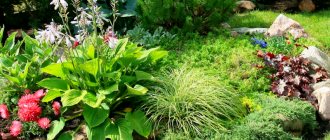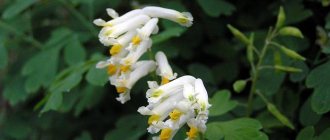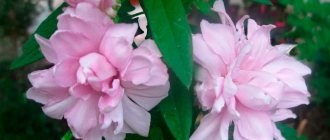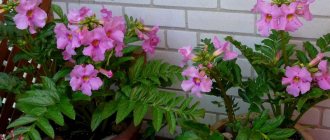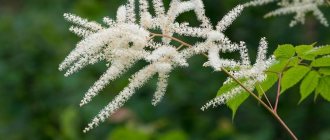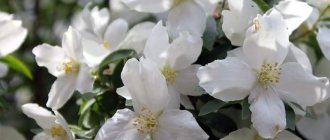Hostas - perennial flowers, species
There are about 40 varieties of hostas, but only a few of them are suitable for home growing:
| View | Height, cm | Leaves |
| Bloated | 50 | Pointed at the tips. |
| Wavy | 75 | They have wavy edges, the central part is white, the edging is green. |
| High | 90-100 | Large, glossy shine. Color – darkish. |
| Siebold | 60 | Medium in size, veins are deep. |
| Curly | 50-60 | Wide. The color is grassy, the edges are white. |
| Podorozhnovaya | 50 | Shiny, bright green. |
| Fortune | 50 | The colors are lush green, the edging is cream. |
Variety in color
Taking into account the color of the foliage, hosta is divided into 5 classes:
- Blue;
- Yellow;
- Green;
- Variegata - varieties with multi-colored foliage, with a light edge along the edges;
- Mediovariegata - light, border - greenish.
Variety in size
Taking into account the dimensions of the plant, it is divided into 6 categories:
- dwarf - less than 10 cm (Draft);
- miniature - from 10 to 15 cm (La Donna);
- small – 16-25 cm (Gold tone);
- medium - from 30 cm to 0.5 m (So Sweet and White Feather, the latter variety with white foliage, which turns green as it grows);
- large – 55-70 cm (Golden Meadows and Alvatine Taylor);
- gigantic - more than 0.7 m (Blue Vision).
Classification
There are several groups based on the external characteristics of both wild and hybrid species. The gradation of plants depends on size. According to the American classification, the following groups can be distinguished:
- dwarf - height does not exceed 10 centimeters;
- miniature – grow up to 15 centimeters;
- small - plants up to 25 centimeters;
- medium - grow up to half a meter;
- large – these hostas can reach 70 centimeters in height;
- gigantic - over 70 centimeters.
There are hosts that belong to intermediate groups of this classification.
In addition to size, the following features may be taken into account:
- leaf shape – round, oval, elongated, heart-shaped;
- type of leaf surface - corrugated, matte, glossy, wavy, bronze-metallic;
- green color – white, golden, gray and blue shades, deep green.
Hosta from seeds at home
Germinating a flower from seeds at home is complicated by the fact that their germination rate is only 70-80%, so the planting material is pre-treated with growth-stimulating drugs (placed in Zircon, Kornevin or Elin solutions for half an hour). Stratification is also practiced (placed in the refrigerator for a month).
It is recommended to purchase the soil mixture in gardening stores, since microorganisms present in ordinary soil negatively affect seedlings and even provoke their death. The composition of the soil is a mixture of perlite and peat in equal proportions.
In March, containers for seedlings are prepared and wiped with alcohol or a weak solution of potassium permanganate. A drainage layer of pebbles is placed at the bottom, supplemented with soil and moistened. The plant is left in this form for several days, and then the hosts are sown; the seeds are laid out on the surface of the ground, observing the maximum interval.
Sprinkle the top with the same substrate that was used previously. Thickness – about 5-7 mm. To preserve moisture, cover the container with polyethylene or glass. Be sure to control that during germination, the ground temperature is +18...+25 °C.
If you follow the technology, the first shoots are observed within a few weeks. Exposure to direct sun, excessive moisture, condensation on the cover are dangerous for the flower. The seedlings are kept in a slightly shaded room.
When 2-3 true leaves appear, the plant is picked. The hosts are moved into separate pots filled 25% with sand. The containers are placed in a tray with water, this will ensure bottom watering.
The next step is hardening. Remove the polyethylene and move the flowers outside; manipulations are performed at an air temperature of more than +18 °C.
Agricultural technology
A favorable period for planting hostas is the beginning of spring. At this time, the frosts will have passed, and the plant will have time to take root before the summer heat.
Hostas care and cultivation should not pose any particular difficulties. Their main stages are discussed below.
As a planting site, you should choose a partially shaded area of the garden. Such places may be under trees or near tall plants. An adult hosta should be in the shade, so when choosing a location you should take into account how tall the flower will grow. All hostas, without exception, love moist soil. You should also make sure that the plant is protected from strong winds.
Hosts
Hosta is an unpretentious plant that grows in regions with very different climates. The most favorable soil for planting is slightly acidic and always moist. Preparing the soil before planting seedlings in the ground involves loosening it 30 centimeters deep and adding compost to enrich the soil.
The holes for seedlings should have the following parameters: deep to the size of the root, twice as wide as the root ball. The distance between flowers is selected in accordance with the variety. This parameter depends on how much the bush grows and varies from 30 to 120 centimeters. Next, the host is placed in the hole so that the upper part of the root is flush with the ground. Cover the root with soil and press firmly around the base. After planting, the plant needs to be watered abundantly.
Growing hosta in open ground
Hostas are placed in open ground in late August or early autumn. 2 weeks before planting, rotted pine bark or manure, leaf soil, and compost are laid out on the selected area. The layer is about 10 cm. The soil is dug up together with organic matter, the depth is somewhere on the bayonet of a shovel. Take 1.5-2 buckets of product per square meter.
30 minutes before planting, water the soil thoroughly. Small and medium-sized specimens are planted at a distance of 20-30 cm, large ones - 30-40 cm. The root system grows horizontally, therefore, the wider the hole, the better the decorative effect. Reacts positively to mulching, the layer is at least 5 cm.
Drop off time
The best time is late spring, since the roots are growing and the leaves have not yet appeared. The deadline is early September. When planted later, the shrubs do not take root.
Selection of healthy seedlings for planting
The healthiest seedlings are selected for planting and further care. To do this, they are examined for rotting and other diseases. The choice is made on strong representatives of culture.
Drop off point
A place for hosta is selected for many years, because the flower is able to grow without transplantation for 20 years. The ideal site is partial shade without drafts, but professionals take into account the rule that the more colorful the foliage, the more light-loving the plant.
For bright representatives of the species, places are selected where there is partial shade at noon and sun the rest of the time.
Soil Features
Select soil that is nutritious and well-drained. Cultivated loam is ideal. Acidity – 6.5-7.5. Never use untreated clay soils and dry sandstones.
Hosta responds positively to the content of organic matter in the soil, therefore, in addition to timely application of fertilizers, the plant is regularly mulched with compost.
Hosta planting stages
The spacing between holes is related to the plant variety placed in the soil:
- small and medium – 30-50 cm;
- giants - 0.8-1 m.
For successful planting, pre-water the seedlings in the pots. It is transported into the holes along with a lump of earth. Sprinkle soil on top and compact it so that the level is 2-3 cm below the rest of the soil.
If planting is carried out by dividing the bush, then dry foliage and spoiled rhizomes are removed from each part.
Preparing the plant for winter
In order for hosta plantain or any other to successfully survive the cold, the following care is necessary:
- Remove all flower stalks.
- Divide the hosta if necessary. You can replant the bushes until mid-September.
- In the south, in central Russia, it is not necessary to cover the hosta. In dry weather, you can only mulch the soil with leaf soil, mown grass, dry peat, rotted sawdust or pine needles. You can sprinkle tobacco dust or “Fitosporin” on top to protect the flower from slugs.
- If you live in the northern region, after mulching the soil, cover the bush with a breathable heat insulator - agrofibre or spruce branches.
Hosta care
When growing and caring for hosts, a number of rules are followed.
Watering
Do it generously and frequently (twice a week). Water is added in the morning. The soil is kept moist, but moisture is not allowed to stagnate, otherwise the plant will be affected by fungus.
Fertilizing
During the growth period, fertilize three times. The first feeding is at the very beginning of growth. The second is after the formation of flowers. The third - after the buds fall off.
It is recommended to combine the application of complex products and compost. Immediately after fertilizing, the soil is mulched.
What to plant next to hostas in the flowerbed, along the fence and path
If you are designing a path along the edges of which you plan to plant hostas, then choose plants of the same variety. It is desirable that these be low-growing varieties. After planting, you need to be patient; the paths bordered by hostas will acquire a decorative appearance and completeness no sooner than after three seasons. You can complement the design with ground covers. Hostas - coleus in red shades will also perfectly complement the greenery. To make the hosta border look more picturesque in the spring, plant low primroses between them: crocuses, hyacinths, muscari.
Hosts along the tracks
When forming a composition along the fence, you can combine hosts with daylilies, irises, astilbe, and roses. In this case, it is necessary to observe tiers. Plan in advance the planting of plants in such a way that the decorative value of each of them is visible to your eye: low-growing plants in the foreground, behind them medium-height ones, and in the background - the tallest ones.
Hosta with hydrangeas
Hosta propagation
Plant propagation is carried out by cuttings and dividing the bush.
Cuttings
Cuttings are carried out at any time from spring to autumn. A part that has its own bud and some rhizomes is separated from the mother bush. The resulting material is placed in the shade and covered with a pre-cut bottle. Over time, the regrowth of missing organs and the formation of normal foliage are observed.
Dividing the bush
Perform in the spring, after germination. The mother bush is carefully removed from the soil, large lumps of earth are removed, and rotten areas are cut off. The plant is cut with a knife or a pointed shovel. Each part must have a bud and a piece of rhizome.
The cuttings are moved into the soil and watered constantly for the first few weeks.
Landing place
Hostas should not be planted in full sun; there should be partial shade. Where the area is illuminated from 12 noon to 5 pm, it is better not to place these plants. I’m planning a place for a flower garden on the north side of the house, and it provides good shade. The sun is there only a couple of hours after sunrise in the morning and only a little bit in the evening. In open areas of the hosta, the foliage fades, the contrasting border fades, and burns appear.
Trees or shrubs growing nearby can also provide partial shade. Constant dense shade will also not benefit the plants. In spring, the ground in such areas takes longer to warm up, as a result of which the development of new shoots is inhibited. And flower stalks may not form at all.
Pests, diseases
During the growth of the hosta, it is affected by various diseases, and gardeners constantly observe insect attacks:
| Pest/disease | Symptom (effect on foliage) | Elimination methods |
| Phyllostiosis | Red-brown spotting. | All diseased leaves are cut off and thrown away. Shrubs are sprayed with Vectra or Abiga-Peak, and colloidal sulfur is often used. |
| Botrytis | Rotting. | Treat with Bordeaux mixture or Topaz. The affected parts are destroyed. |
| Root collar rot | The rhizome is affected. | They dig it up, wash the root system, remove infected areas, and dip it in a light solution of potassium permanganate. Transported to a new location. |
| Slugs | Traces of dried mucus, holes. | A Thunderstorm bait is placed under the flower, covered with plywood in the evening, and pests are collected manually in the morning. |
| Foliar nematodes | Light brown spots. | The affected areas are destroyed. The soil is sprayed with a formaldehyde solution or the flower is moved to a new area, but the roots are first soaked in potassium permanganate. |
With timely detection of diseases and insects, the flower pleases with its flowering for a long time.
Host Features
What do giant hosta leaves and asparagus vegetables have in common? What about indoor asparagus, which looks like dill? They are relatives - the Asparagus family.
The landscape uniqueness of this plant is in its foliage, not in its flowering. The more luxurious the leaves, the scarcer the buds.
The duration will surprise you: easily 20-25 years. Hosta is a long-living herbaceous perennial. She also does not need frequent transplants. Considering the shade-loving nature, there seem to be no disadvantages. It's true: does the queen of the garden have them?
It grows wild in Japan, the Far East and China. Selective forms are cultivated on five continents, except Antarctica.
The root of the bush is not developed; it shoots flower stalks a meter high. Giant leaves are dense, up to 30 cm long and 20 cm wide. Color variations range from variegated light green to blue.
When planning a garden plot, it is important to take into account the bush’s ability to grow in width.
Mr. Summer Resident advises: hosta in landscape design
The plant is widely used in the landscape field due to its decorative properties and shade tolerance. Large representatives of the species are used as single elements; specimens with a size of less than 10 cm are used to decorate alpine slides or ridges. Medium flowers fit harmoniously into various garden compositions.
Hosts emphasize the originality of flower beds and borders. Against the background of modern-style paths or ground cover mats, flowers fully demonstrate their decorative properties.
They are grown in the vicinity of low coniferous perennial plants, ferns, daylilies and a number of other flowering deciduous and ornamental varieties of flora.
What to plant next to hosta in the shade
Hosta companions are plants that do well in shade or partial shade. You can plant next to the hosta:
- Astilbe - will decorate the flowerbed with its blooming panicles;
- Heuchera is an unpretentious plant with bright leaves;
- Fern - will decorate a flowerbed with carved foliage;
- Primroses - add color to the flower garden in spring;
- Hydrangea - to form a bright multi-tiered flower bed.
Hosta with astilbe
Hostas with heucheras
Hosta with fern and ivy
Mulching
Mulching significantly improves moisture and air conditions for hosta roots and prevents drying and hardening of the top layer of soil.
Hosta mulching
Mulch options:
- Shredded bark is the most popular material for mulch.
- Agrotextiles. Flower growers additionally use agrotextiles under the bark, which can significantly reduce the number of weeds. This is especially useful when the seedlings are small and there is a lot of empty space between individual plants. Now you can easily purchase brown agrotextiles, which are much less noticeable as bedding than black ones.
- Needles. When growing hosta among conifers, this natural and cheap material complements the garden design.
Important!!!
Mulching also has disadvantages. It becomes a hiding place for snails and other pests that love to eat the beautiful leaves.
Diseases
Until recently, the crop was considered resistant to disease, but it turned out that the plant can be affected by viruses from other plants (mosaic, ring spot, etc.). But the most common and dangerous of these is the HVX hosta virus, which is transmitted by the sap of an infected bush during procedures such as division or pruning.
Symptoms of the disease caused by the virus: the appearance of spots, transparent specks, lines or streaks, uneven color of foliage, changes in its texture, compactness. The disease completely covers the entire bush, causing leaf loss and delayed development. There is no treatment, therefore, to prevent the spread of the virus at the first symptoms, it is necessary to dig up and burn the plant. Hostas can be planted in the old place after three weeks.
After research, scientists have found that a fairly large number of Hosta Siebold hybrids are resistant to the HVX viral disease.
Description
Perennials are highly decorative thanks to their magnificent leaves, which, depending on the variety, can be green, yellow, bluish, one-color, two-color and even three-color, the so-called. variegated hostas, such as the 'Striptease' variety. The leaf shape is very diverse - from almost round to lanceolate.
Flowering occurs in summer or early autumn and lasts 2-3 weeks. Lilac, purple, pink or white flowers are collected in inflorescences, often on high peduncles. The shape of the flowers can be bell-shaped or funnel-shaped.
